ECO mode Acura RSX 2003 Owner's Manual
[x] Cancel search | Manufacturer: ACURA, Model Year: 2003, Model line: RSX, Model: Acura RSX 2003Pages: 320, PDF Size: 4.24 MB
Page 2 of 320

T his Owner’s Manual should be considered a
permanent part of the vehicle, and should
remain with the vehicle when it is sold.
T he inf ormation and specif ications included
in this publication were in ef f ect at the time
of approval f or printing. Honda Motor Co.,
Ltd. reserves the right, however, to
discontinue or change specif ications or
design at any time without notice and without
incurring any obligation whatsoever. T his Owner’s Manual covers all models of
the Acura RSX. You may f ind descriptions of
equipment and f eatures that are not on your
particular model.
Owner’s Identif ication
POUR CLIENTS CANADIEN
A VIS IMPORT A NT : Si vous avez
besoin d’un Manuel du Conduct eur
en f rançais, veuillez demander à
votreconcessionnairede
commander le numéro de pièce33S6MC10
OWNER
ADDRESS
V. I. N.
DELIVERY DATE
DEALER NAME DEALER NO.
ADDRESS
OWNER’S SIGNATURE
DEALER’S SIGNATURE
STREET
CITY STATE/PROVINCE ZIP CODE/
POSTAL CODE
(Date sold to original retail purchaser)
STREET
CITY STATE/PROVINCE ZIP CODE/
POSTAL CODE
Page 9 of 320

Excessive speed is a major f actor in
crash injuries and deaths. Generally,
the higher the speed the greater the
risk, but serious accidents can also
occur at lower speeds. Never drive
f aster than is saf e f or current
conditions, regardless of the
maximum speed posted.
While airbags can save lives, they
can cause serious or fatal injuries to
occupants who sit too close to them,
or are not properly restrained.
Inf ants, young children, and short
adults are at the greatest risk. Be
sure to f ollow all instructions and
warnings in this manual. (See page
.)
Children are saf est when they are
properly restrained in the back seat,
notthefrontseat.Achildwhoistoo
smallforaseatbeltmustbeproperly
restrained in a child saf ety seat. (See
page .) Having a tire blowout or a
mechanical f ailure can be extremely
hazardous. To reduce the possibility
of such problems, check your tire
pressures and condition f requently,
and perform all regularly scheduled
maintenance. (See page .)
You’ll f ind many saf ety
recommendations throughout this
section, and throughout this manual.
Therecommendationsonthispage
are the ones we consider to be the
most important.
A seat belt is your best protection in
all types of collisions. Airbags
supplement seat belts, but airbags
are designed to inf late only in a
moderate to severe f rontal collision.
So even though your car is equipped
with airbags, make sure you and
your passengers always wear your
seat belts, and wear them properly.
(See page .)
Alcohol and driving don’t mix. Even
one drink can reduce your ability to
respond to changing conditions, and
your reaction time gets worse with
every additional drink. So don’t drink
and drive, and don’t let your f riends
drink and drive, either.
16
21 196
13
Driver and Passenger Saf ety
Important Saf ety Precautions
Always Wear Your Seat Belt
Be Aware of Airbag Hazards Control Your Speed
Restrain All Children K eep Your Car in Saf e Condition
Don’t Drink and Drive
6
Page 25 of 320

Front airbags have been designed to
help protect adults in a moderate to
severe f rontal collision. To do this,
the passenger’s f ront airbag is quite
large, and it inf lates with tremendous
speed.If
the airbag inf lates, it can hit the back
of the child seat with enough force
to kill or very seriously injure an
inf ant.
According to accident statistics,
children of all ages and sizes are
saf er when they are restrained in the
back seat, not the f ront seat. The
National Highway Traf f ic Saf ety
Administration and Transport
Canada recommend that all children
ages 12 and under be properly
restrained in the back seat.
In the back seat, children are less
likely to be injured by striking hard
interior parts during a collision or
hard braking. Also, children cannot
be injured by an inf lating airbag
when they ride in the back.
If you are not wearing a
seat belt in a crash, you could be
thrown f orward into the
dashboard and crush the child.
If youarewearingaseatbelt,the
child can be torn f rom your arms
during a crash. For example, if
your car crashes into a parked
vehicleat30mph(48km/h),a
20-lb (9 kg) inf ant will become a
600-lb (275 kg) f orce, and you will
not be able to hold on.
During a
crash, the belt could press deep
into the child and cause very
serious injuries.
Driver and Passenger Saf ety
Protecting Children
The Passenger’s Front Airbag
Poses Serious Risks to Children
Children Should Sit in the Back
Seat
Inf ant s
Never put a rear-f acing child seat int he f ront seat of a vehicle equippedwit h a passenger’s f ront airbag.
A ddit ional Precaut ions t o Parent s
Neverholdaninfantorchildonyour lap.
Never put a seat belt over yourselfand an inf ant or child.
22
Page 27 of 320
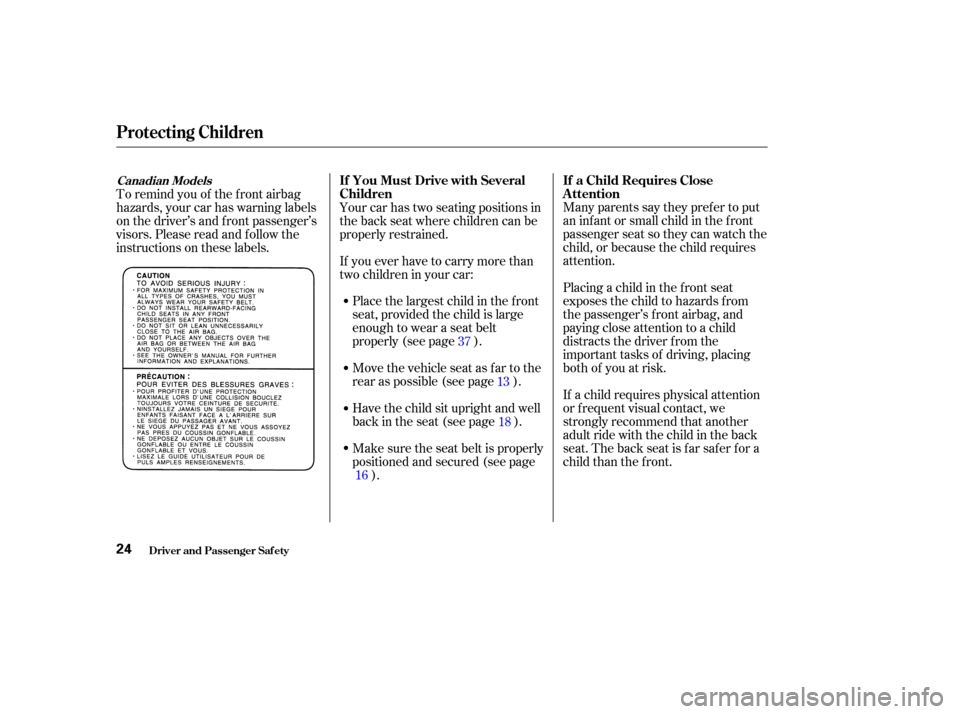
Many parents say they pref er to put
an inf ant or small child in the f ront
passenger seat so they can watch the
child, or because the child requires
attention.
Placing a child in the f ront seat
exposes the child to hazards f rom
the passenger’s f ront airbag, and
paying close attention to a child
distracts the driver f rom the
important tasks of driving, placing
both of you at risk.
If a child requires physical attention
or frequent visual contact, we
strongly recommend that another
adult ride with the child in the back
seat. The back seat is far safer for a
child than the front.
Place the largest child in the f ront
seat, provided the child is large
enough to wear a seat belt
properly (see page ).
Move the vehicle seat as far to the
rear as possible (see page ).
Have the child sit upright and well
backintheseat(seepage ).
Make sure the seat belt is properly
positioned and secured (see page
).
To remind you of the f ront airbag
hazards, your car has warning labels
on the driver’s and f ront passenger’s
visors. Please read and f ollow the
instructions on these labels.
Your car has two seating positions in
the back seat where children can be
properly restrained.
If you ever have to carry more than
twochildreninyourcar:
371318
16
Driver and Passenger Saf ety
Protecting Children
If a Child Requires Close
Attention
If You Must Drive with Several
ChildrenCanadian Models
24
Page 30 of 320

Bef ore purchasing a child seat, we
recommend that parents test the
child seat in the specif ic vehicle
seating position (or positions) where
they intend to use the seat. If a
previously purchased child seat does
not f it, you may need to buy a
dif f erent one that will f it.
Due to variations in the design of
child seats, vehicle seats, and seat
belts, all child seats will not f it all
vehicle seating positions.
A child who is too
large f or a rear-f acing child seat, and
who can sit up without support,
should be restrained in a f orward-
f acing child seat. See page f or
additional inf ormation on protecting
small children. However, Acura is conf ident that one
or more child seat models can f it and
be properly installed in all
recommended seating positions in
your car.
Your car has lower anchorages
installed f or use with LATCH-
compatible child seats. For more
inf ormation, see page .
34 42
CONT INUED
T he child seat should f it the
vehicle seat ing posit ion (orposit ions) where it will be used.
Small Children: 3.
Protecting Children
Driver and Passenger Saf ety27
Page 33 of 320
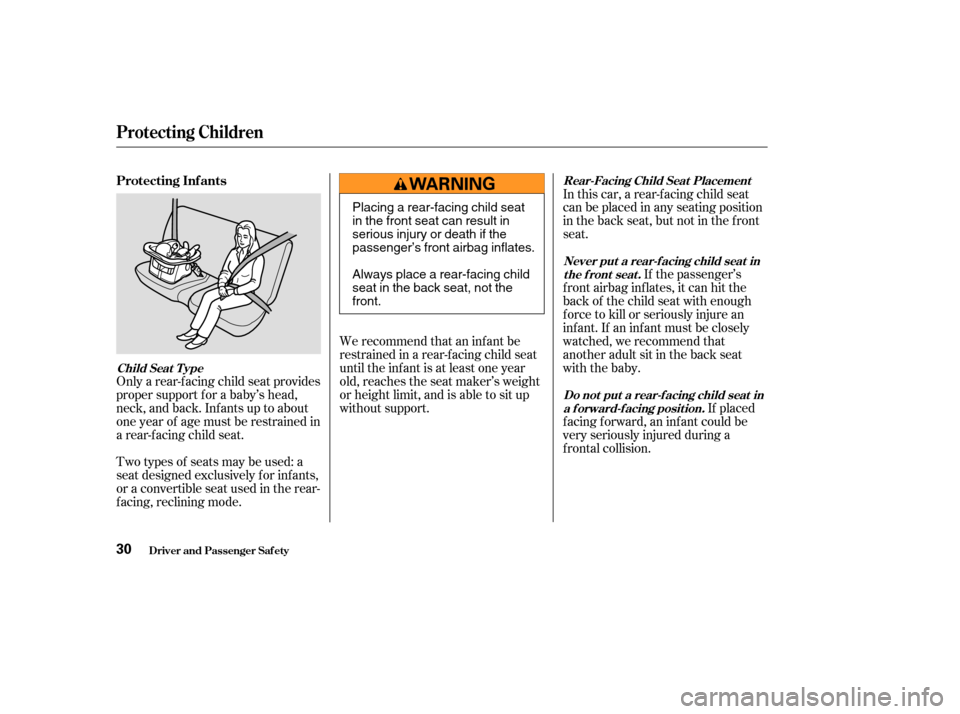
Only a rear-f acing child seat provides
proper support f or a baby’s head,
neck, and back. Inf ants up to about
one year of age must be restrained in
a rear-f acing child seat.In this car, a rear-f acing child seat
can be placed in any seating position
in the back seat, but not in the front
seat.
Two types of seats may be used: a
seat designed exclusively f or inf ants,
or a convertible seat used in the rear-
f acing, reclining mode. If the passenger’s
f ront airbag inf lates, it can hit the
back of the child seat with enough
f orce to kill or seriously injure an
inf ant. If an inf ant must be closely
watched, we recommend that
another adult sit in the back seat
with the baby.
If placed
f acing f orward, an inf ant could be
very seriously injured during a
f rontal collision.
We recommend that an inf ant be
restrained in a rear-f acing child seat
until the inf ant is at least one year
old, reaches the seat maker’s weight
or height limit, and is able to sit up
without support.
Protecting Inf ants
Child Seat T ype
Rear-Facing Child Seat Placement
Never put a rear-f acing child seat inthe front seat.
Do not put a rear-f acing child seat ina f orward-f acing position.
Protecting Children
Driver and Passenger Saf ety30
Placing a rear-facing child seat
in the front seat can result in
serious injury or death if the
passenger’s front airbag inflates.
Always place a rear-facing child
seat in the back seat, not the
front.
Page 51 of 320
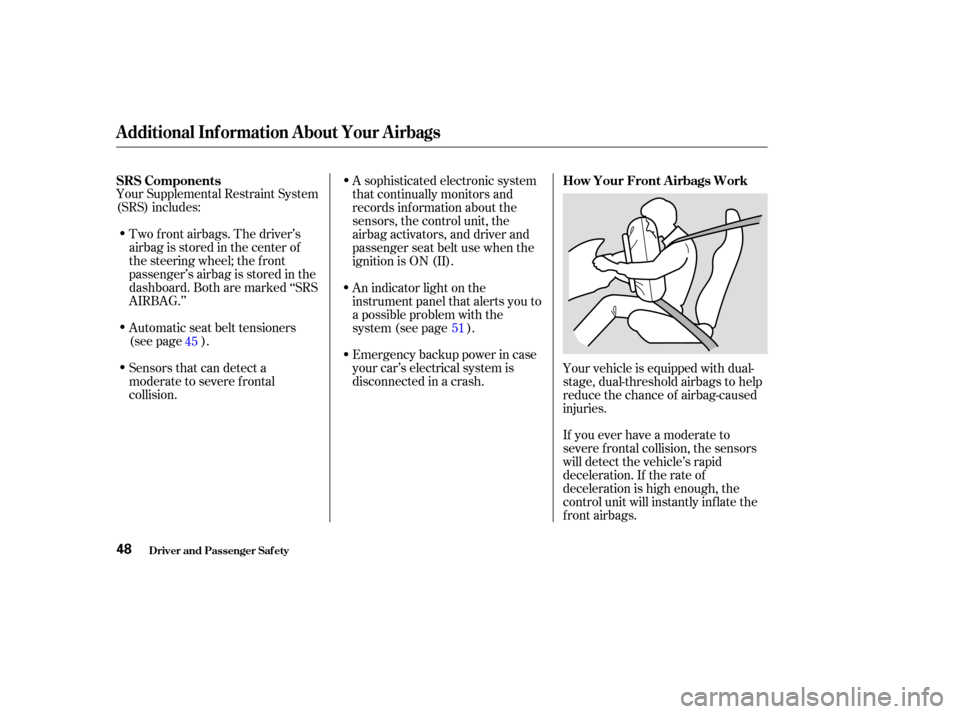
Your Supplemental Restraint System
(SRS) includes:Two f ront airbags. The driver’s
airbag is stored in the center of
the steering wheel; the f ront
passenger’sairbagisstoredinthe
dashboard. Both are marked ‘‘SRS
AIRBAG.’’ A sophisticated electronic system
that continually monitors and
records inf ormation about the
sensors, the control unit, the
airbag activators, and driver and
passenger seat belt use when the
ignition is ON (II).
Sensors that can detect a
moderate to severe frontal
collision. Automatic seat belt tensioners
(see page ). An indicator light on the
instrument panel that alerts you to
a possible problem with the
system (see page ).
Emergency backup power in case
your car’s electrical system is
disconnected in a crash.
If you ever have a moderate to
severe f rontal collision, the sensors
will detect the vehicle’s rapid
deceleration. If the rate of
deceleration is high enough, the
control unit will instantly inf late the
f ront airbags. Your vehicle is equipped with dual-
stage, dual-threshold airbags to help
reduce the chance of airbag-caused
injuries.
45
51
SRS Components
How Your Front A irbags Work
Additional Inf ormation About Your Airbags
Driver and Passenger Saf ety48
Page 58 of 320
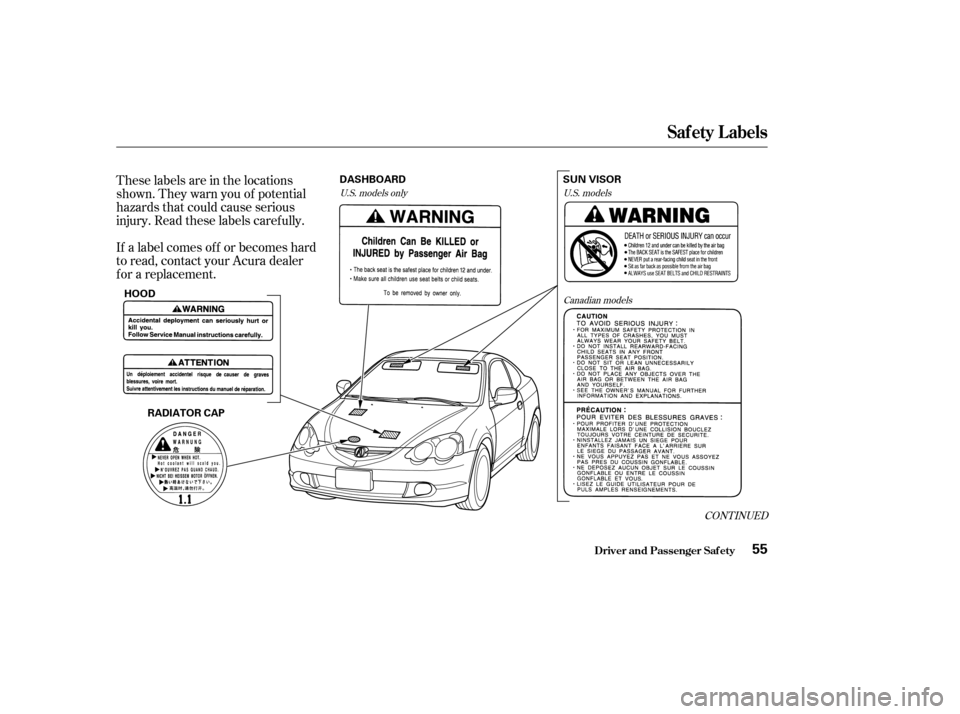
These labels are in the locations
shown. They warn you of potential
hazards that could cause serious
injury. Read these labels caref ully.
If a label comes of f or becomes hard
to read, contact your Acura dealer
f or a replacement.
CONT INUED
U.S. modelsCanadian models
U.S. models only
Saf ety L abels
Driver and Passenger Saf ety55
RADIATOR CAP SUN VISOR
DASHBOARD
HOOD
Page 64 of 320
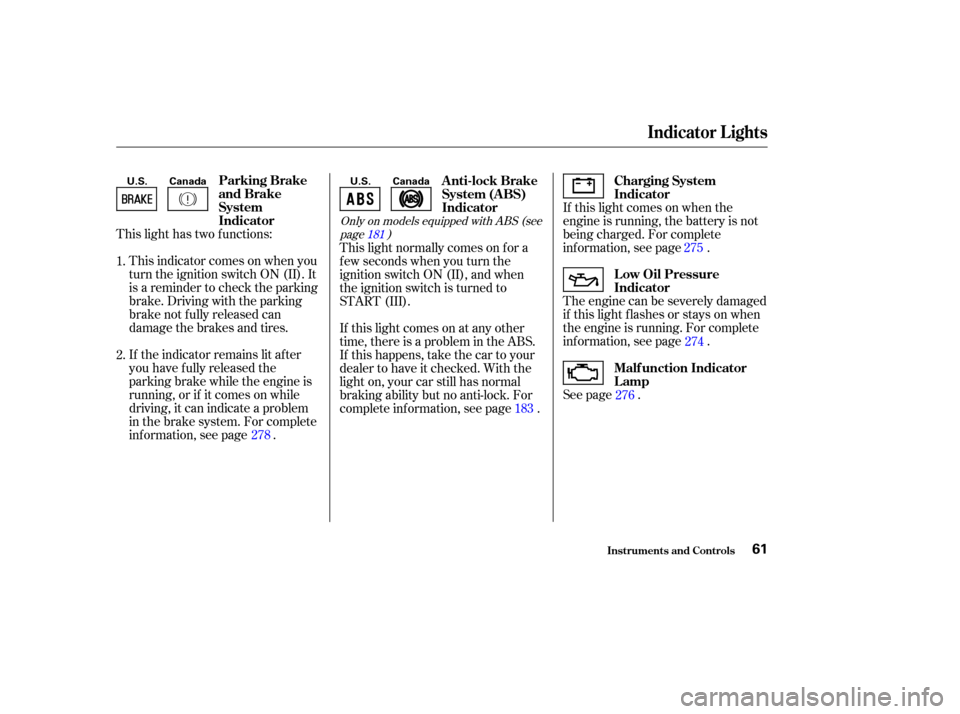
This light has two f unctions:This indicator comes on when you
turn the ignition switch ON (II). It
is a reminder to check the parking
brake. Driving with the parking
brake not f ully released can
damage the brakes and tires.
If the indicator remains lit after
you have f ully released the
parking brake while the engine is
running, or if it comes on while
driving, it can indicate a problem
in the brake system. For complete
inf ormation, see page . If this light comes on when the
engine is running, the battery is not
being charged. For complete
inf ormation, see page .
The engine can be severely damaged
if this light f lashes or stays on when
the engine is running. For complete
inf ormation, see page .
See page .
This light normally comes on f or a
f ew seconds when you turn the
ignition switch ON (II), and when
the ignition switch is turned to
START (III).
If this light comes on at any other
time, there is a problem in the ABS.
If this happens, take the car to your
dealer to have it checked. With the
light on, your car still has normal
braking ability but no anti-lock. For
complete inf ormation, see page .
1.
2.
278 183275
274
276
Only on models equipped with ABS (see page ) 181
Inst rument s and Cont rols
Indicator L ights
Parking Brake
and Brake
System
Indicator Anti-lock Brake
System (A BS)
Indicator
Charging System
Indicator
L ow Oil Pressure
Indicator
Malf unction Indicator
Lamp
61
U.S. Canada
U.S. Canada
Page 66 of 320

This indicator comes on f or a f ew
seconds when you turn the ignition
switch ON (II). It will then go of f if
you have inserted a properly-coded
ignition key. If it is not a properly-
coded key, the indicator will blink
and the engine will not start (see
page ).
This indicator also blinks several
times when you turn the ignition
switch f rom ON (II) to ACCESSORY
(I) or LOCK (0).This indicator lights when you turn
the ignition switch to ON (II) with
the headlight switch of f and the
parking brake set. It should go of f if
youturnontheheadlightsorrelease
the parking brake. If it comes on at
any other time, it means there is a
problem with the DRL. There may
also be a problem with the high
beam headlights.
This light comes on when the
washer f luid level is low. Add washer
f luid when you see this light come on
(see page ).
76 216Canadian models only
Canadian models only
Indicator L ights
Inst rument s and Cont rols
Immobilizer System
Indicator Washer Level Indicator
‘‘Daytime Running
Lights’’ Indicator
63